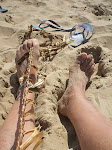With roughly nine weeks left for me to finish new work prior to the opening of Weaving Ghosts the pressure is starting to mount. Nine weeks that inevitably has to include Christmas and New Year celebrations. It is true that I am no fan of Christmas, mainly because it seems to start at the beginning of November and just gets worse until Epiphany and the 'sudden and miraculous realisation' that it is, at last, all over!
Creative pressure, however, is not like other kinds of pressure for me. It seems to be a positive force. The nearer the deadline gets the more I start undoing things that are already almost completed. This would appear to be counterproductive behaviour but, often, it is because I have finally realised that there is a better way to use that material or technique and the remake, if that is what it can be called, usually happens very quickly. Since March this year I have spent many hours making things that I am now unpicking, it's a bit of a kamikaze tactic because there is no time left to do it a second time so this time it will have to work. But, I am a fatalist and think that if my instinct is telling me to undo something then that is what I should do.
The piece that I am most excited about at the moment is something that came together relatively quickly and won't need a remake. But, on reflection, I realise that I have actually been working on the idea for several years and it just didn't manifest itself as a piece of work until now. When something excites me it takes over and I can work very quickly and put in long hours without noticing I am doing so. It is almost as though the speed at which a piece comes together physically is an indication of how successful it will be for me. It doesn't matter if it is a first make or a remake, if it happens quickly it seems to work. That said, I still need to put the hours into making things that get unpicked because without making nothing happens, the ideas come out of the making process, however tedious that may be at times.
An obvious work ethic in art seems to suck the vitality out of it for me, so I deliberately try to make my work look as though it came together without effort, but this can be counterproductive in terms of selling work. Appreciating the manifest gestures of labour in a piece of work is one easy way for the viewer to understand it and its price tag (if it is for sale). There are many contemporary basket makers who use a very obvious visible gesture in a piece to demonstrate that they have put painstaking hours into their work, which in turn will help to justify what appears to be a high price. But often they do it at the expense of what, in French, is referred to as 'poesie' and the work takes on a moribund character becoming nothing more than a demonstration of skill. Its' a trap I try to avoid, so more unpicking awaits....

































